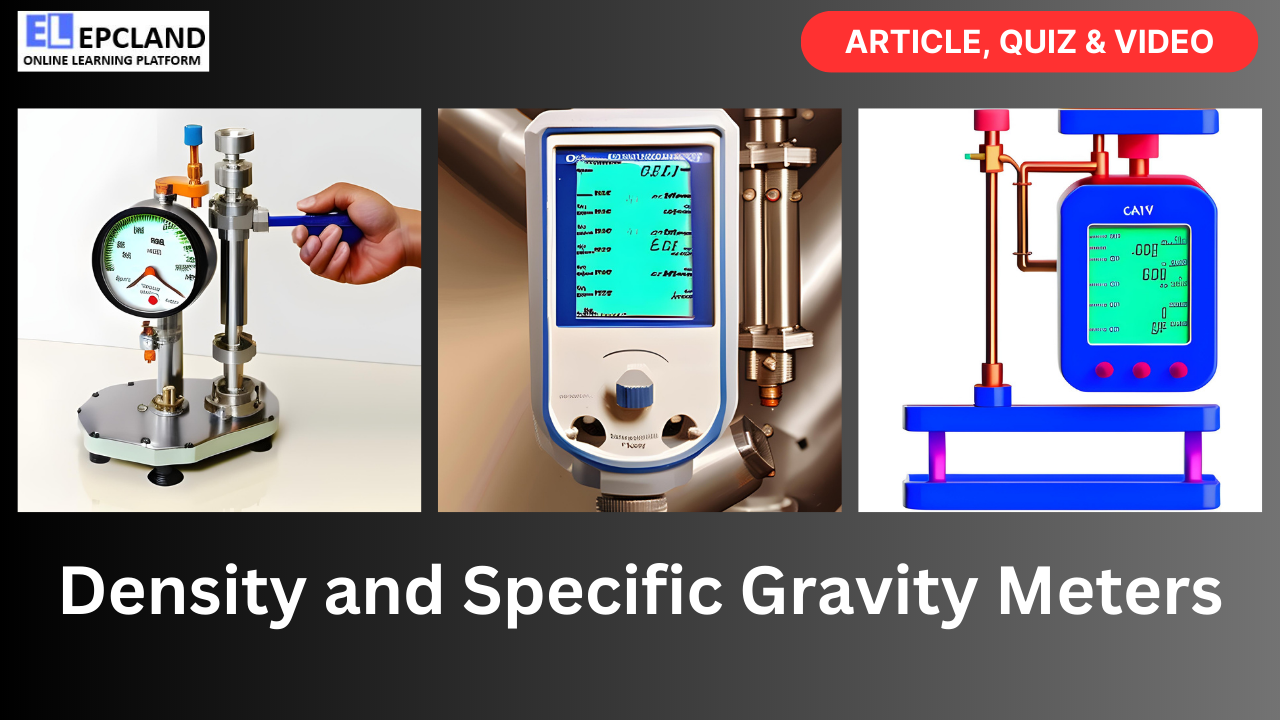In the vast and intricate world of the oil and gas industry, precision and accuracy are paramount. The efficient handling of crude oil, natural gas, and refined products depends on the ability to measure and control various parameters effectively. Among these parameters, density plays a crucial role. Density meters, also known as densitometers or density analyzers, are indispensable tools that aid in ensuring the quality, safety, and profitability of oil and gas operations. This article delves into the significance, principles, types, applications, and emerging trends of density meters in the oil and gas sector.
Table of Contents
Do not miss the Complete Course on Piping Engineering
By EPCLand
Understanding Density in Oil & Gas
What is Density?
Density, in the context of oil and gas, refers to the mass per unit volume of a substance. It is a fundamental physical property that helps characterize different substances, including crude oil, natural gas, and various refined products. Density is typically expressed in units such as kilograms per cubic meter (kg/m³) or pounds per gallon (lb/gal).
Importance of Density
Density is a critical parameter in the oil and gas industry for several reasons:
- Quality Control: Accurate density measurements are essential for determining the composition and quality of crude oil and refined products. Variations in density can indicate impurities or changes in composition.
- Volume and Mass Calculations: Density data are used to convert between volume and mass measurements. This is crucial for fiscal accounting, custody transfer, and inventory management.
- Process Control: In refining and petrochemical processes, maintaining the correct density of feedstocks and products is vital for optimizing production and ensuring product quality.
- Safety: Density is used in safety-related calculations, such as determining the buoyancy of offshore structures and ensuring the safe storage of liquefied natural gas (LNG).
- Environmental Compliance: Density measurements are used to assess the compliance of products with environmental regulations, especially for emissions monitoring and reporting.
Principles of Density Measurement
Density meters operate based on the principles of buoyancy, which rely on Archimedes’ famous principle: “Any object, wholly or partially immersed in a fluid, is buoyed up by a force equal to the weight of the fluid displaced by the object.” In the case of density meters, the fluid is typically the substance whose density is being measured.
The Working Principle
The working principle of density meters is based on Archimedes’ principle. Here’s how it works:
- A sensor or probe is immersed in the fluid whose density is to be measured.
- The sensor measures the force exerted on it by the fluid, which includes both the weight of the sensor itself and the buoyant force acting on it due to the displaced fluid.
- By knowing the volume of the sensor and the density of the fluid displaced by the sensor, the density of the fluid can be calculated using the formula:Density (ρ) = Mass (m) / Volume (V)
- The measured density is then typically displayed digitally or transmitted to control systems for further processing and monitoring.
Types of Density Meters
There are several types of density meters commonly used in the oil and gas industry:
1. Hydrometers
Hydrometers are simple, float-based density measurement devices. They consist of a glass tube with a weighted bottom and a scale. When placed in a sample of the fluid, the hydrometer’s position in the fluid indicates its density. The greater the immersion, the lower the density.
Pros: Low cost, simplicity. Cons: Limited accuracy, not suitable for online or continuous measurement.
2. Pycnometers
Pycnometers are laboratory instruments that measure density by comparing the weight of a known volume of fluid with the weight of an equal volume of a reference fluid, typically distilled water. The density is calculated based on the weight difference.
Pros: High accuracy in a controlled environment. Cons: Time-consuming, not suitable for continuous monitoring.
3. Capacitance Density Meters
Capacitance density meters operate on the principle that the capacitance of a sensor immersed in a fluid changes with the fluid’s dielectric constant, which is directly related to its density. These meters are suitable for both laboratory and online applications.
Pros: Moderate to high accuracy, suitable for continuous measurement. Cons: Sensitive to fluid properties other than density.
4. Radiation-Based Density Meters
Radiation-based density meters use gamma or X-ray radiation to measure the attenuation of radiation passing through the fluid. The degree of attenuation is proportional to the fluid’s density.
Pros: High accuracy, suitable for various fluids. Cons: Requires radiation safety measures, higher cost.
5. Ultrasonic Density Meters
Ultrasonic density meters emit sound waves through the fluid and measure the time it takes for the waves to travel through the fluid. The density is calculated based on the speed of sound, which is influenced by density.
Pros: Non-intrusive, suitable for online measurement. Cons: Sensitive to temperature and pressure variations.
Do not miss the Complete Course on Piping Engineering
By EPCLand
Applications of Density Meters in Oil & Gas Projects
Density meters find extensive use across various stages of oil and gas projects. Their applications include:
1. Exploration and Drilling
In the early stages of oil and gas projects, exploration teams use density measurements to assess the composition of subsurface formations. By analyzing the density of rock formations, geologists can identify potential hydrocarbon reservoirs.
2. Well Logging
Density logs are a common type of well log used in the oil and gas industry. During drilling and well completion, density measurements provide crucial information about the types of fluids encountered in the wellbore, helping engineers make informed decisions about drilling fluids and well completion strategies.
3. Reservoir Characterization
Density measurements are essential for reservoir engineers to characterize the properties of subsurface reservoirs accurately. By analyzing the density of reservoir fluids, engineers can estimate reserves and plan production strategies.
4. Crude Oil and Natural Gas Production
In oil and gas production facilities, density meters are used to monitor the density of produced fluids. This information is critical for controlling separation processes and ensuring that the right products are transported downstream.
5. Refining and Petrochemical Processes
Refineries and petrochemical plants rely on density measurements to control the quality of feedstocks and products. Accurate density data help optimize refining processes, such as distillation and blending, to meet product specifications.
6. Custody Transfer
Density meters play a central role in custody transfer operations, where the ownership and value of hydrocarbon products are transferred between parties. Accurate density measurements are essential for determining the quantity and quality of transferred fluids.
7. Safety in Offshore Operations
In offshore oil and gas operations, density measurements are used to assess the buoyancy of platforms, risers, and subsea equipment. This information is crucial for designing safe and stable offshore structures.
8. Environmental Compliance
Environmental regulations often require monitoring the density of emissions and effluents. Density meters help industries comply with environmental standards by accurately measuring and reporting fluid densities.
Emerging Trends in Density Measurement
The field of density measurement is continually evolving, driven by advancements in technology and the need for higher precision and efficiency. Some emerging trends in density measurement for oil and gas projects include:
1. Digitalization and Connectivity
Modern density meters are equipped with digital interfaces, allowing for real-time data collection and remote monitoring. This connectivity enables operators to access density measurements from anywhere, enhancing control and decision-making.
2. Multi-Parameter Sensors
To increase efficiency and reduce the number of sensors required, manufacturers are developing multi-parameter sensors that can simultaneously measure density along with other properties such as viscosity and temperature.
3. Improved Accuracy and Stability
Advancements in sensor technology and calibration methods are leading to higher accuracy and stability in density measurements. This is particularly important for applications where precision is critical.
4. Integration with Control Systems
Density meters are increasingly being integrated into control systems, allowing for automatic adjustment of processes based on density measurements. This integration enhances process optimization and reduces manual intervention.
5. Non-Intrusive Measurement
Non-intrusive density measurement methods, such as ultrasonic sensors, are gaining popularity due to their ability to measure density without physically contacting the fluid. This reduces maintenance requirements and improves safety.
6. Environmental Monitoring
As environmental regulations become more stringent, density meters are being used for continuous monitoring of emissions and effluents to ensure compliance with environmental standards.
Advantages and Disadvantages of Density Meters
To provide a clear overview of density meters in the oil and gas industry, here is a table summarizing their advantages and disadvantages:
| Advantages | Disadvantages |
|---|---|
| Accurate measurement of density | Costly radiation-based meters |
| Essential for quality control | Hydrometers lack precision |
| Facilitates volume and mass calculations | Limited accuracy in some conditions |
| Crucial for process control | Pycnometers are time-consuming |
| Supports safety calculations | Sensitivity to fluid properties |
| Complies with environmental regulations | Ultrasonic meters affected by temperature and pressure |
Conclusion
Density meters are unsung heroes in the oil and gas industry, quietly ensuring that operations run smoothly, efficiently, and within regulatory compliance. These devices provide critical data that impact exploration, drilling, production, refining, custody transfer, safety, and environmental protection. As technology continues to advance, the role of density meters will only become more significant, contributing to the industry’s ongoing success and sustainability.
In this article, we’ve explored the principles of density measurement, the various types of density meters, their applications throughout oil and gas projects, and the emerging trends shaping the field. By understanding the importance of density and the capabilities of density meters, professionals and stakeholders in the oil and gas industry can make informed decisions, improve processes, and enhance the overall performance of their operations.
Do not miss the Complete Course on Piping Engineering
By EPCLand
FAQs
1. What is the primary role of density meters in the oil and gas industry?
Density meters in the oil and gas industry primarily measure the density of fluids, including crude oil, natural gas, and refined products. Their main role is to ensure quality control, facilitate volume and mass calculations, support process optimization, and comply with safety and environmental regulations.
2. How do radiation-based density meters work, and what are their advantages and disadvantages?
Radiation-based density meters use gamma or X-ray radiation to measure the attenuation of radiation passing through a fluid. The degree of attenuation is proportional to the fluid’s density. Advantages include high accuracy, suitability for various fluids, and compliance with safety regulations. Disadvantages include the need for radiation safety measures and higher cost.
3. Why are density measurements important during well drilling and exploration in the oil and gas industry?
Density measurements during well drilling and exploration provide critical information about the types of fluids encountered in the wellbore. This information helps engineers make informed decisions about drilling fluids, well completion strategies, and the potential presence of hydrocarbon reservoirs.
4. What are some emerging trends in density measurement for oil and gas projects?
Emerging trends in density measurement include digitalization and connectivity for real-time monitoring, the development of multi-parameter sensors that measure density along with other properties, improved accuracy and stability in measurements, integration with control systems for automatic adjustments, non-intrusive measurement methods for reduced maintenance, and increased use for environmental monitoring to comply with stringent regulations.
5. Are density meters sensitive to changes in temperature and pressure, and how is this addressed in the industry?
Some density meters, such as ultrasonic sensors, can be sensitive to changes in temperature and pressure. In the industry, compensation techniques and calibration processes are often used to account for these variations and ensure accurate density measurements. Regular maintenance and calibration of density meters are essential to maintain their reliability.
Recommended courses (Published on EPCLand)
- Basics of Piping Engineering
- Piping Layout Engineering
- Piping Material Engineering
- Piping Stress Analysis
- Complete Course on Piping Engineering
- Material Requisitions
- Piping Material Specifications
- Valve Material Specifications
Don’t miss the published articles on following:
| Article Name with Link | Article Name with Link |
| Future Trends | Basics of Control Valve |
| Principles of Instruments | Control Valves |
| Advanced Control Strategies | HMI Design |
| Automation | PID Controller |
| Calibration | PLC |
| Remote Monitoring and SCADA |
Related Video
Attempt Quiz
Question 1:
What is the primary purpose of a density meter in oil & gas projects?
Explanation: Density meters in oil & gas projects are primarily used to measure the density of fluids, which is crucial for various process control and quality assurance tasks.
Question 2:
Which type of density meter is commonly used for inline density measurements in pipelines?
Explanation: Nuclear density meters are commonly used for inline density measurements in pipelines due to their accuracy and non-intrusive nature.
Question 3:
What is the unit of measurement for fluid density in the International System of Units (SI)?
Explanation: The unit of measurement for fluid density in the SI system is Newtons per square meter (N/m²) or Pascal (Pa).
Question 4:
What are some common applications of density meters in the oil & gas industry?
Explanation: Density meters in the oil & gas industry are commonly used for monitoring the quality of crude oil during refining processes, among other applications.
Question 5:
Why is accurate density measurement important in oil & gas projects?
Explanation: Accurate density measurement in oil & gas projects is important because it helps optimize drilling and production processes, ensuring efficiency and compliance with industry standards.



